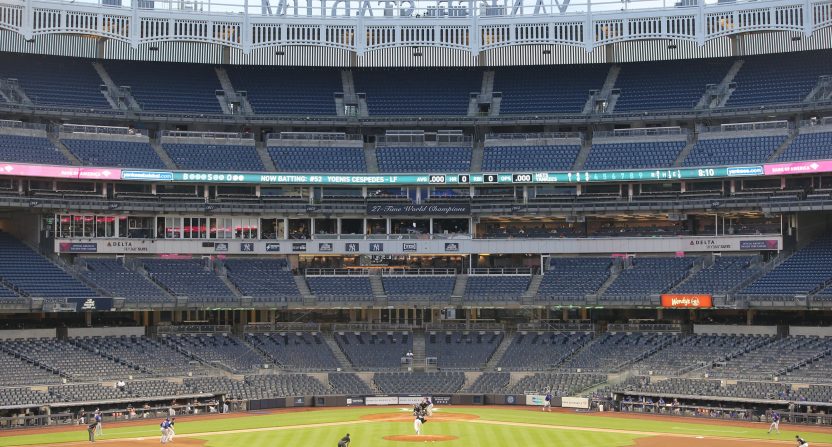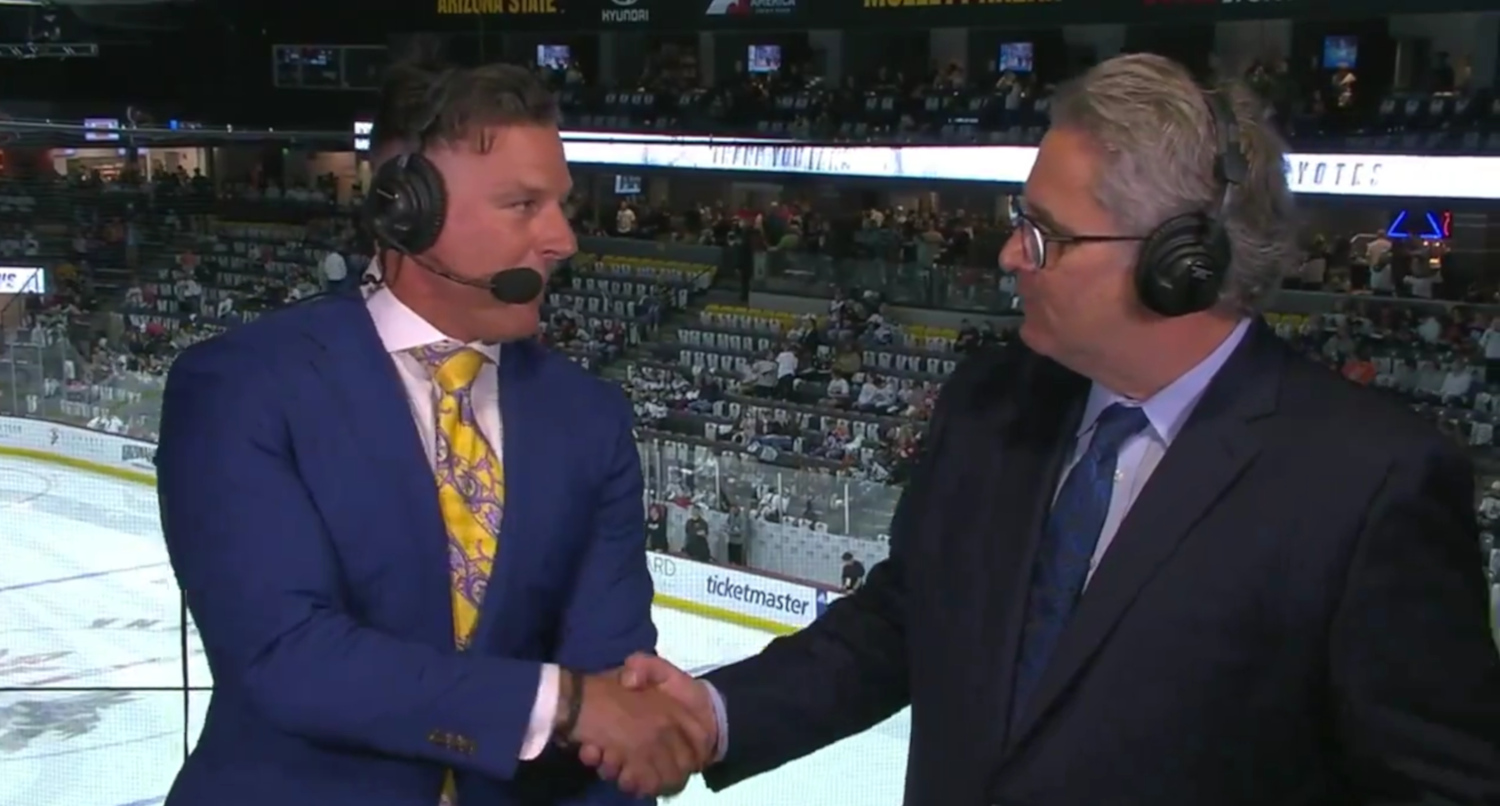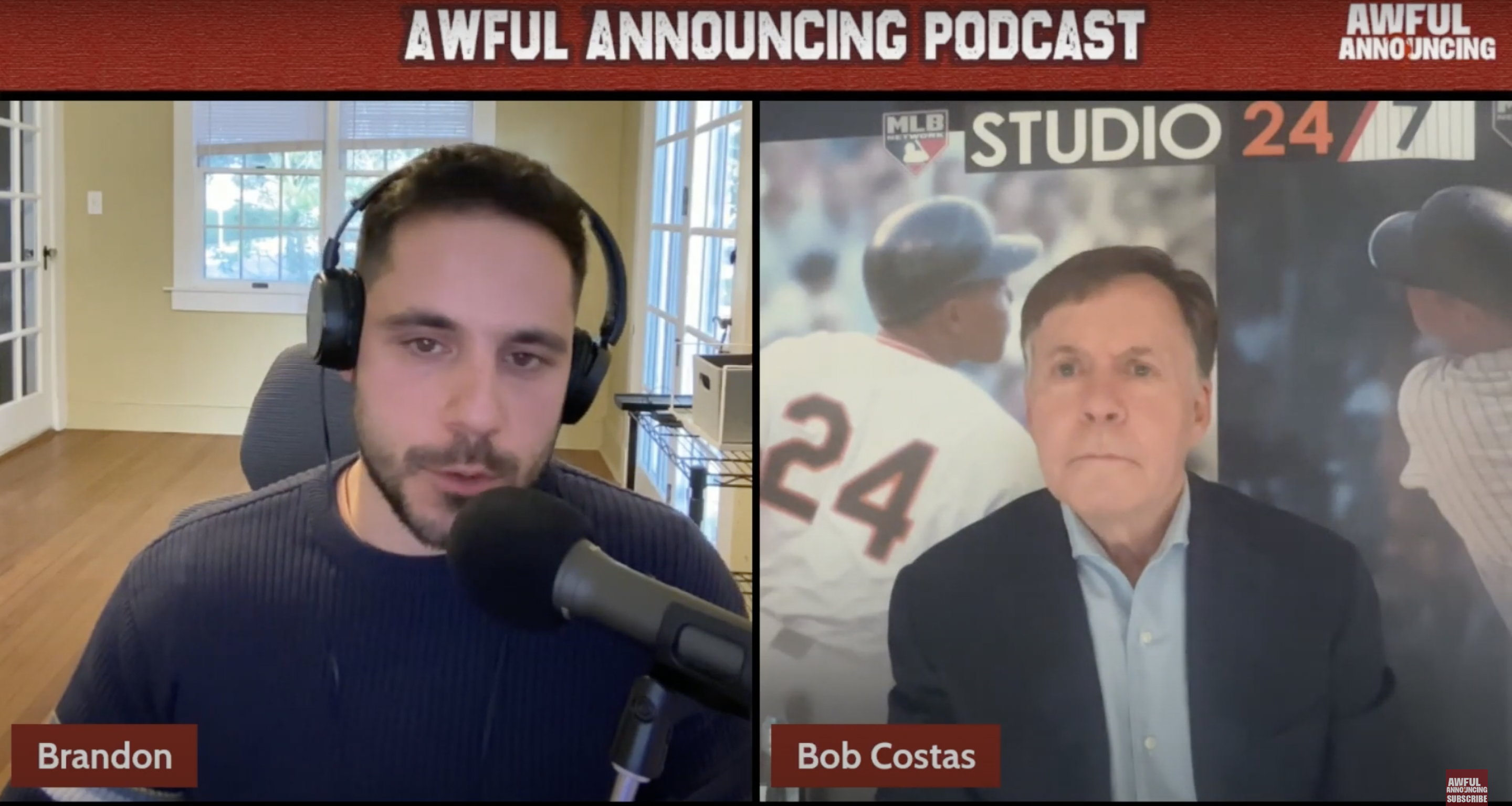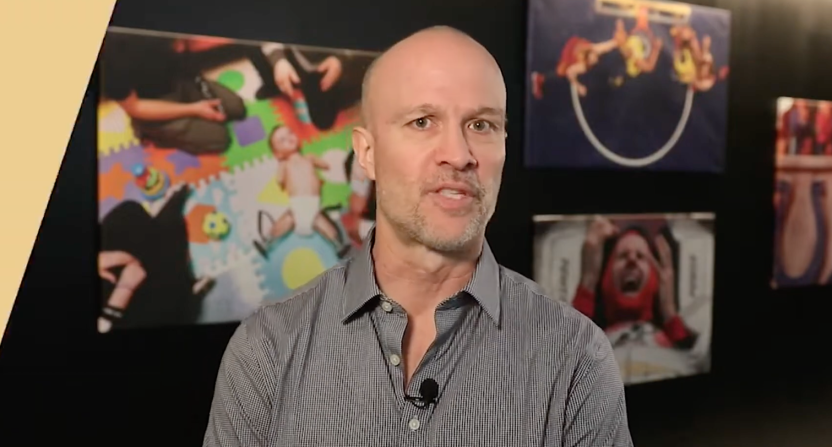Calling fanless games
One huge issue on everyone’s minds is the lack of fans in the stands and the piped in crowd noise that’ll be at every ballpark. It’ll be new and weird and different for everyone involved, which is why the exhibition games weren’t just for the players on the field.
To practice for fanless games during the pandemic, the Royals had Lefebvre call a couple of MLB The Show games to get a feel for what it could be like.
“Without the continuous movement, we rely on that buzz of the crowd in the background. It’s kind of like a companion to make us feel like we don’t have to be talking all the time,” the 49-year-old said. “And then when you take that away, it’s just awkward. And then you pick up things that you’re not normally used to hearing, like a bird chirping or clearly hearing a vendor selling popcorn or maybe some encouragement from the dugout or the reaction of a player when they strike out.”
All of the play-by-play announcers we spoke with for the story wondered what laying out will be like for a big moment when the volume of the fake crowd noise is piped up.
“There’s nothing better than a walkoff when the fireworks go off and you hear the roar of the crowd,” Lefebvre said.
We’ve heard the roar of the fake crowd noise in other sports like soccer, and it just isn’t the same. It won’t be silent at the parks, though, allaying his concern that he’ll have to call a big moment like a putt on the 18th green.
During his Hall of Fame career, Eckersley said the energy of the crowds who watched him play meant a lot to him, and he similarly feeds off that energy when he calls games. Having three people call every Red Sox game this season will be helpful to Eckersley, who said the more, the merrier in this situation.
“I think there needs to be more conversation,” he said.
The increase in conversation during broadcasts is something Vasgersian thought about a lot during those dark quarantine months. It could mean that games with A-Rod and Olney become more linear, more planned out, and easier to storyboard in a sense.
“Once we figure out how it’s gonna go, I think we’ll be able to kind of plan out a telecast more like a show,” Vasgersian said. “You don’t want to limit yourself by saying you’re gonna do this here and this there, but you may be able to do a little more of that than you would under ordinary circumstances.”
You can have a talk-based play-by-play treatment while still not detracting from the fact that you’re calling a game, Vasgersian said. There’s a delicate balance between calling every minute nuance of what happens on each pitch and not focusing on what occurs on the field at all.
“So maybe this is license to do a little bit more, skew it more toward the talk thing,” he said. “I’m not really concerned about that. I’m more interested and I’m really anxious to kind of get going and see how I feel.”
As an analyst, Flaherty often used the crowd noise as a timing mechanism of sorts. When there’s a big moment, he said you need to lay out and let the crowd take over for a little. After a home run call by Yankees play-by-play man Michael Kay, Flaherty sees the crowd and the camera shots for about 15-30 seconds before he follows up with his analysis of how that player was able to take a pitch and hit it over the fence.
“That might change now without the full crowd noise and that energy,” Flaherty said.
Where Blum usually calls Houston games at Minute Maid Park is right in front of the club section, so one of the first things he thinks about is the interaction with the fans. How the fans are cheering and reacting is a major way he judges the momentum and feel of a game.
“That’s probably going to be the hardest part, getting into that stadium for our first home game against the Seattle Mariners,” Blum said, “and realize that even though it’s Opening Day, it’s definitely not going to have that feel without the fans in there. You’re not necessarily relying on the fans, but you definitely want to feel the energy to help judge how we use our voices to call some of those games.”
In a large piece of weird and twisted irony, the lack of fans will likely be a huge help for the Astros in 2020. The players were not only getting prepared for the season, Blum said, but also preparing to be the target of a lot of hate and vitriol that was around the league concerning the 2017 cheating scandal that led to the firings of both manager A.J. Hinch and general manager Jeff Lunhow, along with fines and the loss of draft picks.
“In Spring Training, every conversation or every game we called it was ‘what’s the atmosphere gonna be like?’” Blum said. “Every interview we had with those guys is ‘how are you gonna handle being on the road’ because of the sign stealing scandal. And now the pandemic hits, we kind of back off and the thought of getting back on the field is all that’s focused on. So I think it’s going to benefit the Astros in a sense. They can focus on the game happening on the field and not how they’re gonna have to handle 40,000 fans booing them every time they step up to the plate.”
Where’s the access?
Aside from the fans in the stands, one of the biggest changes from Spring Training to the games being played this summer is the loss of access baseball’s broadcasters will have to the players and clubhouses, going down to the field and chatting with players, coaches, media, executives and fellow broadcasters during batting practice before games. Martinez called that period the most important part of his day during a normal 162-game season.
“That’s where I get the information that I believe separates me from a lot of people, to bring something fresh each day to the broadcast,” he said
Even if you don’t use what a particular player says right away, it may be vital to a broadcast in the days and weeks after.
“I’m really gonna miss that opportunity,” Martinez said.
Those opportunities with players and coaches is what helps get Lefebvre and Rex Hudler through the dog days of the season, even when Kansas City is in contention. Lefebvre was told by Royals media relations that when they’re on the road, he can give them questions to have them answered for the broadcasts, but he’ll still miss that personal element that builds and maintains lasting relationships that are vital to their jobs.
“Even if I read a great story about a player, there’s that little extra ingredient of adding what the player told me before the game in regards to that story,” Lefebvre said. “Talking to coaches and players gave us the little nuggets that were fresh every day.”
A big part of Flaherty’s gameday prep is talking to coaches and ex-teammates on the field, and not having the ability to do that is the worst part of the pandemic season for him.
“Batting practice was the best time to get work done,” he said.
A lot of what Blum and Kalas say on Astros broadcasts are from these personal interactions with players. They can then convey their thoughts and what they said during a player’s at bat, a relief appearance, or when they make a nice play in the field. Everyone’s going to have to be creative to fill those gaps in their subsequent broadcasts, though texting and phone and Zoom calls will help.
“Hopefully we can be creative, but not to the extent that we’re making stuff up just to have something to say,” Blum said with a laugh. “But it’s gonna be a true team effort for every broadcast team out there to really pool your information and be a little more open to conversation than really relying on one person for getting some of those backstories.”
Like every team relies on their reporters to gather information about players, Blum relies on Julia Morales to gather information for broadcasts. Now she won’t be able to do that in person, and the information she relays during games isn’t necessarily about what happens on the field, but maybe it’s about a player’s wife giving birth or someone’s charity initiative.
“It’s trying to make them a little more human as they go through these situations, or maybe get their ideas or get their thoughts on playing through a pandemic situation like this,” Blum said. “It would be incredibly valuable, not only to our broadcast but to the fans at home.”
What Eckersley will miss most is the daily interactions he has with the other broadcast teams, who will give out vital information a lot more readily than players would.
“They can fill you in in a matter of minutes and bring you up to speed with that team,” he said. “It’s more informative than anything.”
While Vasgersian is no longer a local broadcaster, he still remembers what it’s like to interact with all the familiar faces he’d see at the ballpark every day and how much that means to the announcers across the 30 teams.
“Whether it’s a guy who works in a clubhouse or a groundskeeper or someone from a front office, it’s not just players and coaches,” he said. “I’ll definitely miss those interactions. That’s the fun part of it.”
All he can do now is hope that the players will be open to doing their interviews over the phone and Zoom.
“Hopefully they’re not restricted by the format and they feel like even though they’re not looking us in the eye,” Vasgersian said, “they can still give us information that helps us make the telecast smarter.”
Is it safe to play?
On the day the 2020 season finally begins, it’s still a question that hangs over the sport like the Sword of Damocles. There’s no bubble, and players and teams are going to be traveling on planes, trains and automobiles and staying at hotels. There’s nothing really stopping them from putting themselves and their teammates at risk other than their own moral sensibilities.
Blum played for six different teams across 14 MLB seasons and knows that it’s going to be tough for players to not explore all the cities when they travel like they normally would on a road trip.
“It’s gonna be very hard for a lot of these guys to go into hotels and know that their favorite restaurant is down the street,” he said. “And that’s where the accountability comes in. And for these athletes, it’s am I gonna be selfish and go get what I want, or am I gonna be selfless and stay in my room, make sure that I’m not the weak link that brings this virus into my ballclub.”
Flaherty played for five different teams across 14 MLB seasons and knows just how many people outside the team players interact with on a normal road trip and how that’s going to cause a whole new level of concern across what Blum called 30 traveling bubbles.
“There’s gotta be a trust factor with these players that they’re doing the right thing,” Flaherty said, “not only for each other but when you go back home, you gotta see your family.”
Eckersley wants to see the season played safely and is happy the sport is back, but acknowledges that there are cracks in the system and that things can definitely go haywire this season.
“What’s it gonna take to stop this game?” he asked. “The question is, should they have played to begin with? You can go either way on that, because the country may be worse off than we were four months ago. I don’t know. We started this whole process with having to be in a bubble, considering what they were going to do in a bubble, and now they’re not in one.”
Lefebvre astutely notes that until there’s a vaccine, there’s a new normal for everything that goes on in this world. And so the 2020 season can and should be used as a test run to see what works and what doesn’t in preparation for the 2021 campaign.
“What do you do when a player, or two, or three test positive?” he asked. “What’s the protocol and does it work? What needs to be changed? And there’s really no way to figure that out until you go out and do it.”
Blum heard an interview with Astros general manager James Click, who said that whoever can limit the spread of the virus in their clubhouse may end up winning it all. And players and teams have to be ready for an outbreak hitting their roster at any time.
“We might as well get mentally prepared for the fact that somebody is gonna break that rule, somebody is gonna get infected,” Blum said. “The traveling bubble is gonna be a real issue in trying to contain that and minimize the spread if it happens. Hopefully, MLB can limit the exposure and keep these guys safe enough to get through a full season.”
Ready or not, Vasgersian said, the MLB season is here. And like everyone in 2020, broadcasters are going to have to adjust with the times and roll with the punches.
“A lot of guys are toe-in-the-water about it, but I’m really excited about this,” he said. “It’s not gonna come around again, hopefully, so let’s try to make something fun of it.”







